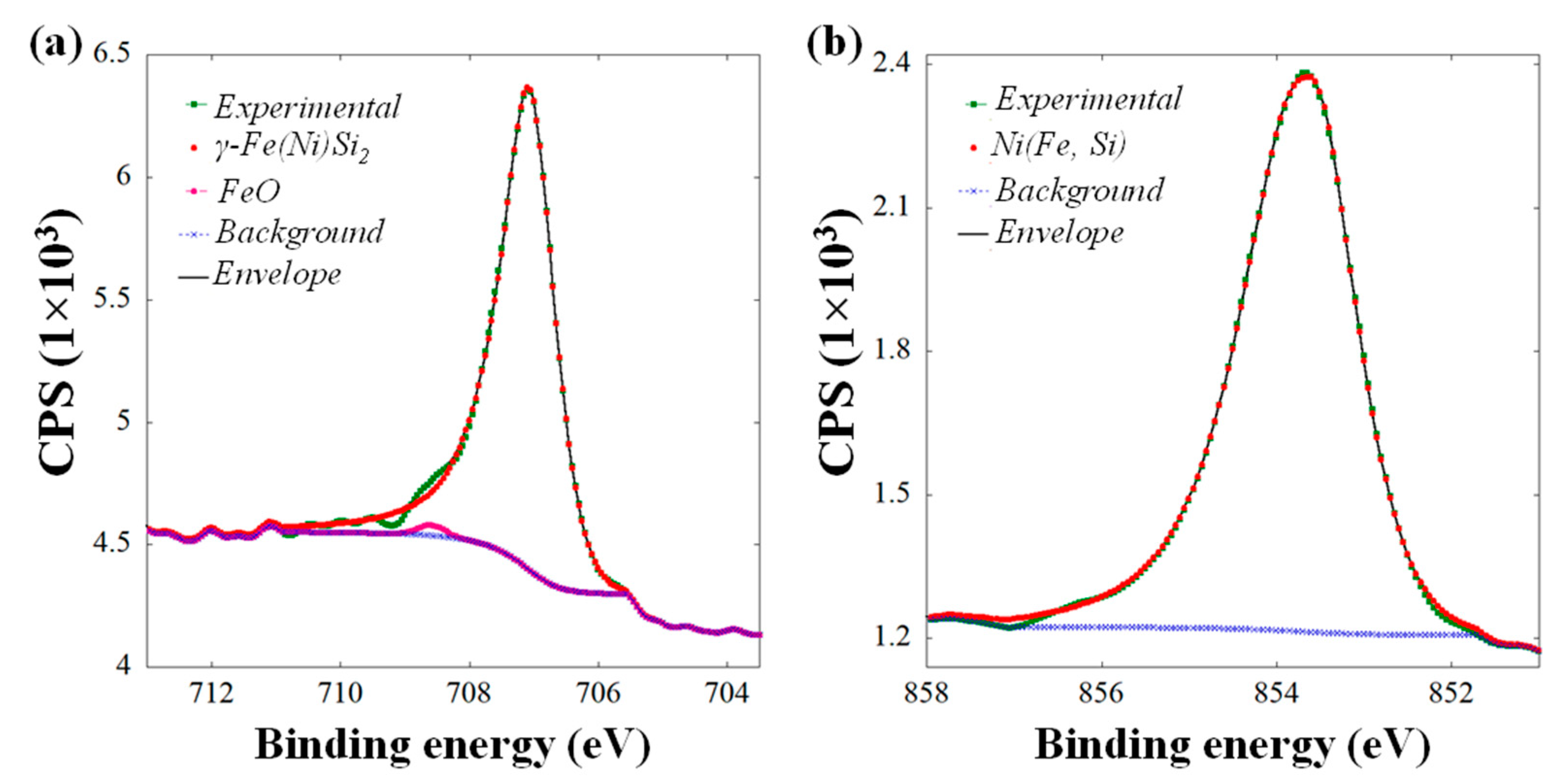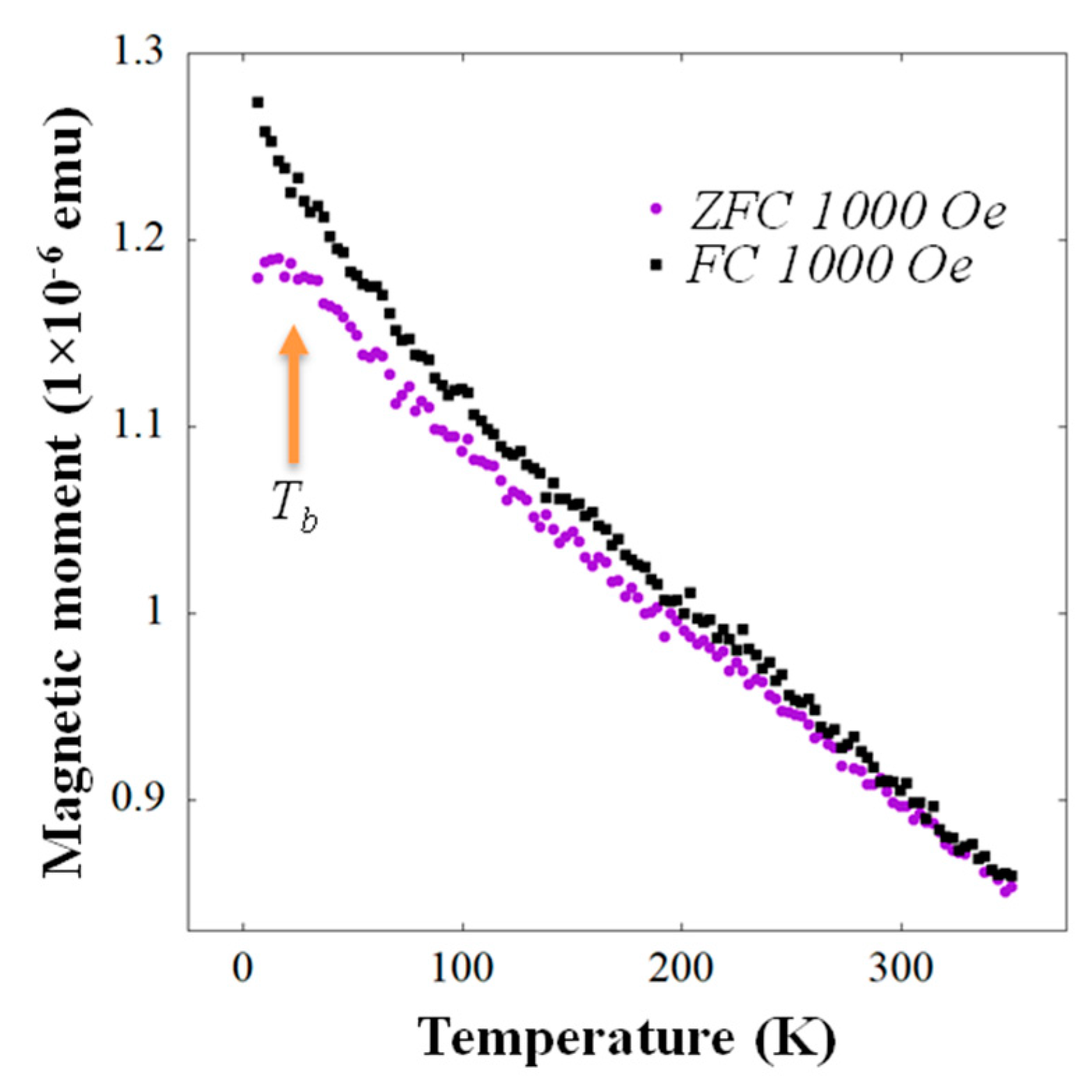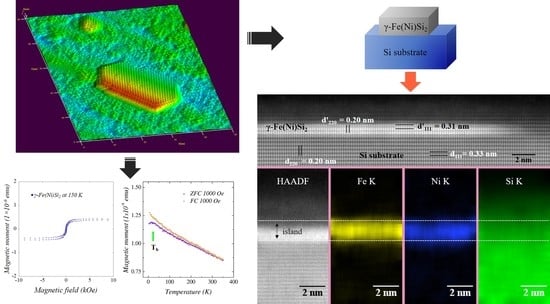Lattice-Match Stabilization and Magnetic Properties of Metastable Epitaxial Permalloy-Disilicide Nanostructures on a Vicinal Si(111) Substrate
Abstract
1. Introduction
2. Methods
3. Results and Discussion
3.1. Morphological Evolution upon Annealing
3.2. XPS Study of the Nanodisk Bonding Chemistry
3.3. Structural and Compositional Analysis
3.4. Magnetometry
4. Conclusions
Author Contributions
Funding
Institutional Review Board Statement
Informed Consent Statement
Data Availability Statement
Acknowledgments
Conflicts of Interest
References
- Hirohata, A.; Yamada, K.; Nakatani, Y.; Prejbeanu, I.-L.; Diény, B.; Pirro, P.; Hillebrands, B. Review on spintronics: Principles and device applications. J. Magn. Magn. Mater. 2020, 509, 166711. [Google Scholar] [CrossRef]
- Lin, X.; Yang, W.; Wang, K.L.; Zhao, W. Two-dimensional spintronics for low-power electronics. Nat. Electron. 2019, 2, 274–283. [Google Scholar] [CrossRef]
- Nandwana, V.; Chaubey, G.S.; Yano, K.; Rong, C.-B.; Liu, J.P. Bimagnetic nanoparticles with enhanced exchange coupling and energy products. J. Appl. Phys. 2009, 105, 014303. [Google Scholar] [CrossRef]
- Lee, J.; Kim, J.; Kim, D.; Lee, G.; Oh, Y.-B.; Hwang, T.-Y.; Lim, J.-H.; Cho, H.-B.; Kim, J.; Choa, Y.-H. Exchange-coupling interaction in zero- and one-dimensional Sm2Co17/FeCo core-shell nanomagnets. ACS Appl. Mater. Interfaces 2019, 11, 26222–26227. [Google Scholar] [CrossRef]
- Jiang, J.S.; Pearson, J.E.; Liu, Z.Y.; Kabius, B.; Trasobares, S.; Miller, D.J.; Bader, S.D. Improving exchange-spring nanocomposite permanent magnets. Appl. Phys. Lett. 2004, 85, 5293. [Google Scholar] [CrossRef]
- Jiang, J.S.; Pearson, J.E.; Liu, Z.Y.; Kabius, B.; Trasobares, S.; Miller, D.J.; Bader, S.D. A new approach for improving exchange-spring magnets. J. Appl. Phys. 2005, 97, 10K311. [Google Scholar] [CrossRef]
- Liu, Y.; Wu, Y.Q.; Kramer, M.J.; Choi, Y.; Jiang, J.S.; Wang, Z.L.; Liu, J.P. Microstructure analysis of a SmCo/Fe exchange spring bilayer. Appl. Phys. Lett. 2008, 93, 192502. [Google Scholar] [CrossRef]
- Zeng, H.; Li, J.; Liu, J.P.; Wang, Z.L.; Sun, S. Exchange-coupled nanocomposite magnets by nanoparticle self-assembly. Nature 2002, 420, 395–398. [Google Scholar] [CrossRef] [PubMed]
- Hamdeh, H.H.; Eltabey, M.M.; Ho, J.C.; Lee, P.C.; Chen, K.; Chen, Y.Y. Magnetism in nanoparticles of semiconducting FeSi2. J. Magn. Magn. Mater. 2010, 322, 2227–2230. [Google Scholar] [CrossRef]
- Seo, K.; Varadwaj, K.S.K.; Mohanty, P.; Lee, S.; Jo, Y.; Jung, M.-H.; Kim, J.; Kim, B. Magnetic Properties of Single-Crystalline CoSi Nanowires. Nano Lett. 2007, 7, 1240–1245. [Google Scholar] [CrossRef]
- Chen, Y.Y.; Lee, P.C.; Tsai, C.B.; Neeleshwar, S.; Wang, C.R.; Ho, J.C.; Hamdeh, H.H. Chemical disorder-induced magnetism in FeSi2 nanoparticles. Appl. Phys. Lett. 2007, 91, 251907. [Google Scholar] [CrossRef]
- Shi, H.; Chang, L.; Jia, R.; Eglitis, R.I. Ab initio calculations of the transfer and aggregation of F centers in CaF2. J. Phys. Chem. C 2012, 116, 4832–4839. [Google Scholar] [CrossRef]
- Bedanta, S.; Kleemann, W. Supermagnetism. J. Phys. D Appl. Phys. 2009, 42, 013001. [Google Scholar] [CrossRef]
- Coey, J.M.D. Magnetism and Magnetic Materials; Cambridge University Press: New York, NY, USA, 2010. [Google Scholar]
- Petracic, O. Superparamagnetic nanoparticle ensembles. Superlattices Microstruct. 2010, 47, 569–578. [Google Scholar] [CrossRef]
- Tripathi, J.K.; Levy, R.; Camus, Y.; Dascalu, M.; Cesura, F.; Chalasani, R.; Kohn, A.; Markovich, G.; Goldfarb, I. Self-organized growth and magnetic properties of epitaxial silicide nanoislands. Appl. Surf. Sci. 2017, 391, 24–32. [Google Scholar] [CrossRef]
- Goldfarb, I.; Camus, Y.; Dascalu, M.; Cesura, F.; Chalasani, R.; Kohn, A. Tuning magnetic response of epitaxial iron-silicide nanoislands by controlled self-assembled growth. Phys. Rev. B 2017, 96, 045415. [Google Scholar] [CrossRef]
- Tripathi, J.K.; Garbrecht, M.; Kaplan, W.D.; Markovich, G.; Goldfarb, I. The effect of Fe-coverage on the structure, morphology and magnetic properties of α-FeSi2 nanoislands. Nanotechnology 2012, 23, 495603. [Google Scholar] [CrossRef][Green Version]
- Dascalu, M.; Cesura, F.; Levi, G.; Diéguez, O.; Kohn, A.; Goldfarb, I. Controlling the supermagnetic response of tetragonal α-FeSi2 nanoislands. Appl. Surf. Sci. 2019, 476, 189–197. [Google Scholar] [CrossRef]
- Tripathi, J.K.; Markovich, G.; Goldfarb, I. Self-ordered magnetic α-FeSi2 nano-stripes on Si(111). Appl. Phys. Lett. 2013, 102, 251604. [Google Scholar] [CrossRef]
- Goldfarb, I.; Cesura, F.; Dascalu, M. Magnetic Binary Silicide Nanostructures. Adv. Mater. 2018, 30, 1800004. [Google Scholar] [CrossRef] [PubMed]
- Goldfarb, I. Step-mediated size selection and ordering of heteroepitaxial nanocrystals. Nanotechnology 2007, 18, 335304. [Google Scholar] [CrossRef]
- Tripathi, J.K.; Garbrecht, M.; Sztrum-Vartash, C.G.; Rabani, E.; Kaplan, W.D.; Goldfarb, I. Coverage-dependent self-organized ordering of Co- and Ti-silicide nanoislands along step-bunch edges of vicinal Si(111). Phys. Rev. B 2011, 83, 165409. [Google Scholar] [CrossRef]
- Liang, S.; Islam, R.; Smith, D.J.; Bennett, P.A.; O’Brien, J.R.; Taylor, B. Magnetic iron silicide nanowires on Si(110). Appl. Phys. Lett. 2006, 88, 113111. [Google Scholar] [CrossRef]
- Massalski, T.B.; Okamoto, H.; Subramanian, P.R.; Kacprzak, L. Binary Alloy Phase Diagrams, 2nd ed.; ASM International: Materials Park, OH, USA, 1990. [Google Scholar]
- Leong, D.; Harry, M.; Reeson, K.J.; Homewood, K.P. A silicon/iron-disilicide light-emitting diode operating at a wavelength of 1.5 μm. Nature 1997, 387, 686–688. [Google Scholar] [CrossRef]
- Christensen, N.E. Electronic structure of β-FeSi2. Phys. Rev. B 1990, 42, 7148. [Google Scholar] [CrossRef]
- Gomoyunova, M.V.; Malygin, D.E.; Pronin, I.I.; Voronchikhin, A.S.; Vyalikh, D.V.; Molodtsov, S.L. Initial stages of iron silicide formation on the Si(100) 2 × 1 surface. Surf. Sci. 2007, 601, 5069–5076. [Google Scholar] [CrossRef]
- Wallart, X.; Nys, J.P.; Tételin, C. Growth of ultrathin iron silicide films: Observation of the γ-FeSi2 phase by electron spectroscopies. Phys. Rev. B 1994, 49, 5714. [Google Scholar] [CrossRef]
- Onda, N.; Henz, J.; Müller, E.; Mäder, K.A.; von Känel, H. Epitaxy of fluorite-structure silicides: Metastable cubic FeSi2 on Si(111). Appl. Surf. Sci. 1992, 56–58, 421–426. [Google Scholar] [CrossRef]
- Von Känel, H.; Onda, N.; Sirringhaus, H.; Muller-Gubler, E.; Goncalves-Conto, S.; Schwarz, C. Epitaxial phase transitions in the iron/silicon system. Appl. Surf. Sci. 1993, 70–71, 559–563. [Google Scholar] [CrossRef]
- Alvarez, J.; de Parga, A.L.V.; Hinarejos, J.J.; de la Figuera, J.; Michel, E.G.; Ocal, C.; Miranda, R. Structural phase transition during heteroepitaxial growth of iron silicides on Si(111). Appl. Surf. Sci. 1993, 70–71, 578–582. [Google Scholar] [CrossRef]
- Liang, S.; Islam, R.; Smith, D.J.; Bennett, P.A. Phase transformation in FeSi2 nanowires. J. Cryst. Growth 2006, 295, 166–171. [Google Scholar] [CrossRef]
- Geng, L.D.; Dhoka, S.; Goldfarb, I.; Pati, R.; Jin, Y.M. Origin of magnetism in γ-FeSi2/Si(111) nanostructures. Nanomaterials 2021, 11, 849. [Google Scholar] [CrossRef]
- Bhukta, A.; Levi, G.; Horvitz, D.; Kohn, A.; Goldfarb, I. Self-organized exchange-spring magnet in epitaxial β-Fe(Ni)Si2/Si system. Appl. Surf. Sci. in press.
- Casa XPS; Casa Software: Wilmslow, UK, 2001. Available online: http://www.casaxps.com/ (accessed on 31 January 2021).
- Shirley, D.A. High-resolution X-ray photoemission spectrum of the valence bands of gold. Phys. Rev. B 1972, 5, 4709. [Google Scholar] [CrossRef]
- Dascalu, M.; Diéguez, O.; Geng, L.D.; Pati, R.; Jin, Y.M.; Goldfarb, I. Tomographic layer-by-layer analysis of epitaxial iron-silicide nanostructures by DFT-assisted STS. Appl. Surf. Sci. 2019, 496, 143583. [Google Scholar] [CrossRef]
- Nagai, Y.; Senda, M.; Toshima, T. XPS investigations of Ni-Fe alloy and Fe films. Jpn. J. Appl. Phys. 1987, 6, 1131. [Google Scholar] [CrossRef]
- Asami, K.; Hashimoto, K.; Shimodaira, S. X-ray photoelectron spectrum of Fe2+ state in iron oxides. Corros. Sci. 1976, 16, 35–45. [Google Scholar] [CrossRef]
- Marchetti, L.; Miserque, F.; Perrin, S.; Pijolat, M. XPS study of Ni-base alloys oxide films formed in primary conditions of pressurized water reactor. Surf. Interface Anal. 2015, 47, 632–642. [Google Scholar] [CrossRef]
- Nesbitt, H.W.; Legrand, D.; Bancroft, G.M. Interpretation of Ni2p XPS spectra of Ni conductors and Ni insulators. Phys. Chem. Miner. 2000, 27, 357–366. [Google Scholar] [CrossRef]
- Grosvenor, A.P.; Biesinger, M.C.; Smart, R.S.C.; McIntyre, N.S. New interpretations of XPS spectra of nickel metal and oxides. Surf. Sci. 2006, 600, 1771–1779. [Google Scholar] [CrossRef]
- Yu, G.H.; Zhao, H.C.; Li, M.H.; Zhu, F.W.; Lai, W.Y. Interface reaction of Ta/Ni81Fe19 or Ni81Fe19/Ta and its suppression. Appl. Phys. Lett. 2002, 80, 455–457. [Google Scholar] [CrossRef]
- Khan, W.; Wang, Q.; Jin, X. Effect of target composition and sputtering deposition parameters on the functional properties of nitrogenized Ag-Permalloy flexible thin films deposited on polymer substrates. Materials 2018, 11, 439. [Google Scholar] [CrossRef] [PubMed]
- Tam, P.L.; Nyborg, L. Sputter deposition and XPS analysis of nickel silicide thin films. Surf. Coat. Technol. 2009, 203, 2886–2890. [Google Scholar] [CrossRef]
- Salou, M.; Lescop, B.; Rioual, S.; Lebon, A.; Youssef, J.B.; Rouvellou, B. Initial oxidation of polycrystalline Permalloy surface. Surf. Sci. 2008, 602, 2901–2906. [Google Scholar] [CrossRef]





| Phase | Binding Energy (eV) | FWHM (eV) | Line Shape | Concentration (%) |
|---|---|---|---|---|
| γ-Fe(Ni)Si2 | 707.08 | 0.92 | A(0.35, 0.36, 0) GL(53.3333) | 98.88 |
| FeO | 708.59 | 0.50 | GL(0) | 1.12 |
| Ni(Fe, Si) | 853.61 | 1.22 | GL(67.6667) T(1.53) | 100 |
Publisher’s Note: MDPI stays neutral with regard to jurisdictional claims in published maps and institutional affiliations. |
© 2021 by the authors. Licensee MDPI, Basel, Switzerland. This article is an open access article distributed under the terms and conditions of the Creative Commons Attribution (CC BY) license (https://creativecommons.org/licenses/by/4.0/).
Share and Cite
Bhukta, A.; Horvitz, D.; Kohn, A.; Goldfarb, I. Lattice-Match Stabilization and Magnetic Properties of Metastable Epitaxial Permalloy-Disilicide Nanostructures on a Vicinal Si(111) Substrate. Nanomaterials 2021, 11, 1310. https://doi.org/10.3390/nano11051310
Bhukta A, Horvitz D, Kohn A, Goldfarb I. Lattice-Match Stabilization and Magnetic Properties of Metastable Epitaxial Permalloy-Disilicide Nanostructures on a Vicinal Si(111) Substrate. Nanomaterials. 2021; 11(5):1310. https://doi.org/10.3390/nano11051310
Chicago/Turabian StyleBhukta, Anjan, Dror Horvitz, Amit Kohn, and Ilan Goldfarb. 2021. "Lattice-Match Stabilization and Magnetic Properties of Metastable Epitaxial Permalloy-Disilicide Nanostructures on a Vicinal Si(111) Substrate" Nanomaterials 11, no. 5: 1310. https://doi.org/10.3390/nano11051310
APA StyleBhukta, A., Horvitz, D., Kohn, A., & Goldfarb, I. (2021). Lattice-Match Stabilization and Magnetic Properties of Metastable Epitaxial Permalloy-Disilicide Nanostructures on a Vicinal Si(111) Substrate. Nanomaterials, 11(5), 1310. https://doi.org/10.3390/nano11051310







